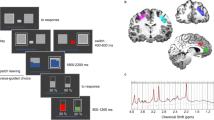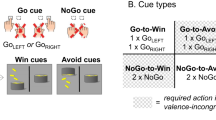Abstract
Although the ventromedial prefrontal cortex (vmPFC) has long been implicated in reward-guided decision making, its exact role in this process has remained an unresolved issue. Here we show that, in accordance with models of decision making, vmPFC concentrations of GABA and glutamate in human volunteers predict both behavioral performance and the dynamics of a neural value comparison signal. These data provide evidence for a neural competition mechanism in vmPFC that supports value-guided choice.
This is a preview of subscription content, access via your institution
Access options
Subscribe to this journal
Receive 12 print issues and online access
$209.00 per year
only $17.42 per issue
Buy this article
- Purchase on Springer Link
- Instant access to full article PDF
Prices may be subject to local taxes which are calculated during checkout


Similar content being viewed by others
References
Wunderlich, K., Rangel, A. & O'Doherty, J.P. Proc. Natl. Acad. Sci. USA 106, 17199–17204 (2009).
Gershman, S.J., Pesaran, B. & Daw, N.D. J. Neurosci. 29, 13524–13531 (2009).
Padoa-Schioppa, C. & Assad, J.A. Nature 441, 223–226 (2006).
Cai, X., Kim, S. & Lee, D. Neuron 69, 170–182 (2011).
Boorman, E.D., Behrens, T.E., Woolrich, M.W. & Rushworth, M.F. Neuron 62, 733–743 (2009).
Bechara, A., Tranel, D. & Damasio, H. Brain 123, 2189–2202 (2000).
Ratcliff, R. & Rouder, J.N. Psychol. Sci. 9, 347–356 (1998).
Wong, K.F. & Wang, X.J. J. Neurosci. 26, 1314–1328 (2006).
Hunt, L.T. et al. Nat. Neurosci. 15, 470–476 (2012).
Hare, T.A., Schultz, W., Camerer, C.F., O'Doherty, J.P. & Rangel, A. Proc. Natl. Acad. Sci. USA 108, 18120–18125 (2011).
Stagg, C.J., Bachtiar, V. & Johansen-Berg, H. Curr. Biol. 21, 480–484 (2011).
Schoenbaum, G., Roesch, M.R., Stalnaker, T.A. & Takahashi, Y.K. Nat. Rev. Neurosci. 10, 885–892 (2009).
Rushworth, M.F., Noonan, M.P., Boorman, E.D., Walton, M.E. & Behrens, T.E. Neuron 70, 1054–1069 (2011).
Hasler, G. et al. Arch. Gen. Psychiatry 64, 193–200 (2007).
Stagg, C.J. et al. J. Physiol. (Lond.) 589, 5845–5855 (2011).
Deichmann, R., Gottfried, J.A., Hutton, C. & Turner, R. Neuroimage 19, 430–441 (2003).
Tversky, A. & Kahneman, D. J. Risk Uncertain. 5, 297–323 (1992).
Zhang, Y., Brady, M. & Smith, S. IEEE Trans. Med. Imaging 20, 45–57 (2001).
Smith, S.M. et al. Neuroimage 23 (suppl. 1), S208–S219 (2004).
Boorman, E.D., Behrens, T.E., Woolrich, M.W. & Rushworth, M.F. Neuron 62, 733–743 (2009).
Wang, X.J. Neuron 36, 955–968 (2002).
Usher, M. & McClelland, J.L. Psychol. Rev. 108, 550–592 (2001).
Ditterich, J., Mazurek, M.E. & Shadlen, M.N. Nat. Neurosci. 6, 891–898 (2003).
Acknowledgements
This work was supported by a Wellcome Trust Research Career Development fellowship to T.E.J.B. (WT088312AIA). L.T.H. was supported by a 4-year D.Phil. studentship from the Wellcome Trust (WT080540MA). J.N. is supported by the UK Medical Research Council. We are very grateful to A. Soltani for providing the MATLAB code for the biophysical model. We thank S. Knight for his valuable help in data acquisition.
Author information
Authors and Affiliations
Contributions
G.J. designed the research, and acquired and analyzed the data. L.T.H. modified the biophysical model and analyzed the biophysical model predictions. J.N. acquired and analyzed MRS data. T.E.J.B. designed the research and analyzed the data. All authors were involved in writing the manuscript.
Corresponding author
Ethics declarations
Competing interests
The authors declare no competing financial interests.
Supplementary information
Supplementary Text and Figures
Supplementary Figures 1–4 and Supplementary Tables 1 and 2 (PDF 989 kb)
Rights and permissions
About this article
Cite this article
Jocham, G., Hunt, L., Near, J. et al. A mechanism for value-guided choice based on the excitation-inhibition balance in prefrontal cortex. Nat Neurosci 15, 960–961 (2012). https://doi.org/10.1038/nn.3140
Received:
Accepted:
Published:
Issue Date:
DOI: https://doi.org/10.1038/nn.3140
This article is cited by
-
Discrimination exposure impacts unhealthy processing of food cues: crosstalk between the brain and gut
Nature Mental Health (2023)
-
Association of default-mode network neurotransmitters and inter-network functional connectivity in first episode psychosis
Neuropsychopharmacology (2023)
-
Dissociable roles of cortical excitation-inhibition balance during patch-leaving versus value-guided decisions
Nature Communications (2021)
-
Glutamine-to-glutamate ratio in the nucleus accumbens predicts effort-based motivated performance in humans
Neuropsychopharmacology (2020)
-
From high- to one-dimensional dynamics of decision making: testing simplifications in attractor models
Cognitive Processing (2020)



